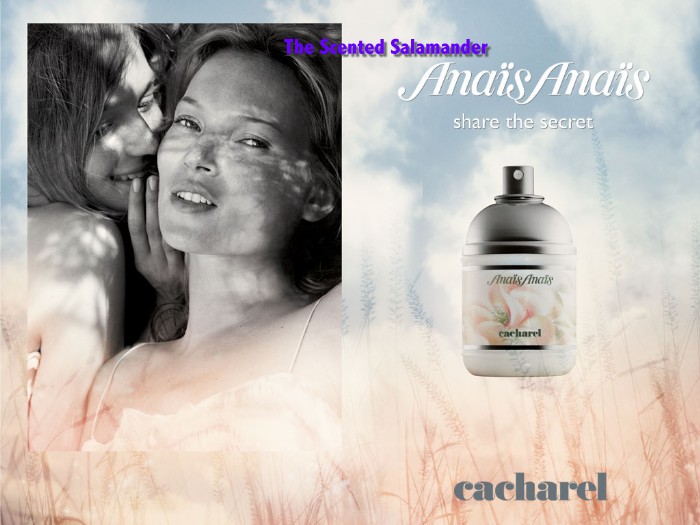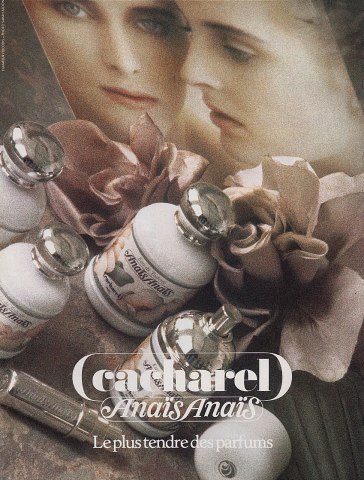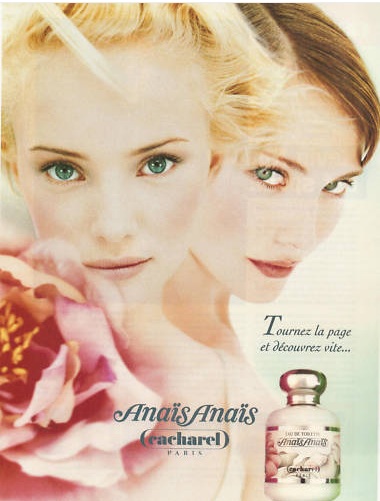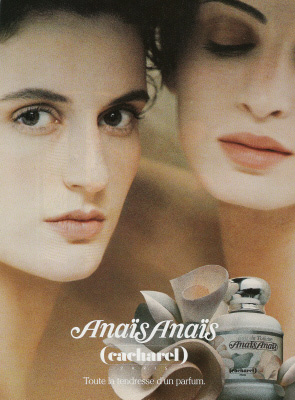Cacharel Anaïs Anaïs is Dedicated to the Goddess of Love (1978) {Perfume Review & Musings}

With its tender image and slogan "One day the world will be awash in tenderness," Anaïs Anaïs by Cacharel, was launched in 1978 as the conscious anti-thesis to the musk and patchouli oils trailing off the hippie Woodstock grounds but also to their nemesis, the conquering Charlie-type woman in business straight pants and jacket. It may lure you into thinking that you will experience an innocent pastel floral scent fit for young girls only. While the main marketing aim of the project was indeed at the time to woo the young, it still remains that 50% of its wearers turned out to be older than 25 years old. To be influenced by the images of the fragrance would be to forget the dual olfactory pull of the fragrance itself which from the start was purposefully designed to convey a sense of being both "tender and sexy." Rediscovering the perfume today is to realize its little advertized yet undeniable sexual character. The reason one should retry this perfume and consider it as a seductive option for Valentine's Day, is in my opinion due to its unique brand of sexiness. If you want a date-musk which is not Kiehl's, nor The Body Shop White Musk, nor Narciso Rodriguez for Her, (the two first which are wafting harder onto the street from the stores these days prior to the 14th of February) and test a different formula of feminine scented sexuality, give Anaïs Anaïs a whirl...

In contrast to the photography signed by Sarah Moon which helped construct the image of Anaïs Anaïs as a symbol of neo-romanticism, the four perfumers who worked on the composition - Paul Léget, Raymond Chaillan, Roger Gonnon and Roger Pellegrino of Firmenich - all made sure that the perfume would feel much less coy than it looked. Today, the authentic character of its sexy-skin accord strikes you not like a whiff of animalic indiscretion in the admittedly classical Gallic tradition unafraid of civet, castoreum and other impudent beasts, but rather like a sensuality which is deeply inscribed in the floral character of the fragrance to the point where it feels completely unaware of itself. It is the innocence and sensuality of Eve before the Fall. She didn't know, she didn't try, she just was sensual, like a flower in the heat / in heat.
The artifice here of course is that Anaïs Anaïs is a complex arrangement of floral notes artfully designed to recreate nature. While it was based on the idea of a lily soliflore originally, the composition was progressively made more complex following the concept of a lush white bouquet all the while using a green-floral structure.

The fragrance was named after the ancient Persian goddess of love, Anaïtis, which is mentioned by Engels in The Origin of the Family, Private Property and the State when broaching the topic of the practice of sacred prostitution, a telling spiritual lineage. As Michael Edwards recalls in his book Perfume Legends, the name came out of the blue to the creative team, possibly - one can surmise as an influence of the author Anaïs Nin (but this is not specified) - then, the choice was rationalized and approved of when it was found that it looked like a short name for Anaïtis. In the same manner, the final fragrance composition to be selected was identified because it was the one which offered the best synergy with the white opaline flacon, a throwback to the 19th century vanity table. Meanwhile, the quatuor of perfumers developed a paradoxical creation which feels both virginal and very femme, like a bride who has benefited from the advice of at least four generations of women in her family prior to her wedding night.
Top notes: hyacinth, orange blossom; heart notes: tuberose, jasmine, honeysuckle, muguet, rose, carnation, ylang-ylang, iris; base notes: sandalwood, cedarwood, amber, incense, musk, leather. (cf. Perfume Legends.)
Regarding the notes of Anaïs Anaïs, it is striking to see how even the scientific literature varies about the contents of the perfume. People smell different things in the perfume; part of the problem, if it is one at all, is that a floral note like lily needs to be recreated using other floral notes. The scent is therefore bound to appear multivariegated. Personally, my nose is very sensitive to the hyacinth character of the fragrance, much more than to its lily accord. The green hyacinth-blackcurrant accord was reportedly worked upon by perfumer Roger Pellegrino. Nose Guy Robert notes in Les Sens du Parfum that hyacinth, like narcissus, has a complex scent; I can only concur with this assessment remembering my smelling heady hyancinths over the course of a week at my home and being struck by their ever-evolving nuances in time.
 A delicious bluish-white spray of flowers opens the fragrance. In it, the hyacinth note is very distinct, curiously even skewing the bouquet towards a soliflore. The floral scent offers a slight rubbery edge which you are not necessarily supposed to notice. It is there as a verist accent and to respect the character of the hyacinth flower in nature by sketching out some of its asperities; it is not there to make a controversial statement. The preservation of a slightly nauseabond note - a typical French approach to perfumery - prevents Anaïs Anaïs from turning into a maudlin bouquet of flowers meant to stereotypically embody spring and innocence.
A delicious bluish-white spray of flowers opens the fragrance. In it, the hyacinth note is very distinct, curiously even skewing the bouquet towards a soliflore. The floral scent offers a slight rubbery edge which you are not necessarily supposed to notice. It is there as a verist accent and to respect the character of the hyacinth flower in nature by sketching out some of its asperities; it is not there to make a controversial statement. The preservation of a slightly nauseabond note - a typical French approach to perfumery - prevents Anaïs Anaïs from turning into a maudlin bouquet of flowers meant to stereotypically embody spring and innocence.
The renewal accents of springtime are evoked by crushed green, sappy nuances. The hyacinth note here also develops a cooked-leek-y nuance, which makes it a cousin in olfaction to the green lentisc. In real life, it is a nuance you start smelling more and more as the hyacinth dies and its flesh literally becomes deliquescent, melting in the water of the vase like the flesh of a cadaver flower. Hyacinths are prone to liquefying overtime embodying perhaps like no other flowers the idea of an exhaling, agonizing flower.
While the hyacinth note is quite dominant, behind it, one can feel the clearer, crystalline notes of honeysuckle and muguet. Rose of course is here. There is an indolic jasmine note too. A spicy lily can be spotted in the bouquet. A powdery, clove-y carnation contributes to both the light cosmetic dusting-powder and spicy aspects of the fragrance.
I recognize in this lush, vernal bouquet the green-floral streak which was characteristic of the 1970s and in particular I immediately identify Fidji by Guy Laroche which was created in 1966 by perfumer Josephine Catapano. In a more intellectual manner, L'Air du Temps by Nina Ricci is another ancestor to Anaïs Anaïs, particularly apparent in the carnation nuance but without the fizz of the aldehydes; Anaïs Anaïs is much calmer.
The Eau de Toilette is lightly powdery for added femininity but without ever hinting at the baby range of Pampers powdery notes. In its current version, the leather note has all but vanished to my nose, replaced it seems by the rubbery hyacinth nuance acting as a masculine, understated brash tonality. After all, it seems, Charlie's lesson of emancipation was not completely discarded.
The main surprise comes for me in the realization that behind the dominant image of an innocent floral scent, Anaïs Anaïs is actually dead sexy. There is a natural-feeling floral muskiness to the scent which is very sexy in neither a clean nor a dirty way but a very Eve-like way, one unaware of her erotic attraction before the exit from Paradise. It is an unselfconscious type of sexiness.
It is only very steathily that some of the secret of the sensuality of Anaïs Anaïs is given away: a heady orange blossom note which once again plays up the feminine range of its floral tonality rather than its baby-scent associations. The listed ylang-ylang must also be contributing its aphrodisiac quality. The naturally musky facet of blackcurrant certainly does, recalling Chamade by Guerlain and coinciding the same year with the release of L'Artisan Parfumeur Mûre et Musc in the more confidential sector of the niche-perfume industry.
Jellinek notes that there is an overdose of musk in the composition and a significant contribution of the aldehyde C14, the latter to give Anaïs Anaïs a fruity, tropical feel which explains to me why I perceive the composition as evolving into "narcotic" territory at one point in time.
The very interesting part is that apparently and somewhat on the sly, secretly as is habitual in the tradition-bound perfume industry, Anaïs Anaïs benefited not only from feminine ancestral advice but from fairly recent research at the time on the musk Exaltolide also called Cyclopentadecanolide, which was used to a proportion of 4% in the scent.
A 1967 article in the Journal of Applied Physiology by Jacqueline Scola Vierling and John Rock examines the effect of Exaltolide on women and men as a so-called pheromone, following a 1952 research by Le Magnen. The twist is that its perception was found to be strongest among sexually mature women than with sexually mature men or young girls who barely noticed it, if at all. The threshold of perception was lowest at the peak of the ovulation cycle, aided by the presence of estrogen. Once more, we have to deal with the paradox of perfume as being a psychological tool for women rather than a direct men magnet. It is because a woman feels sexy by wearing a certain perfume that she will come across as sexy rather than lasso in invisibly men by their noses. Scent therefore, for men, can be seen as being more of an olfactory signal associated with the general aura of a woman, her presence and visual impact.
I happened to be comparing the perfume, serendipitously, with Ange et Démon by Givenchy in the orange-blossom harvest edition and while the latter appeared much more heavy-lidded and conventionally sensual initially, comparing them side by side made me realize that in fact Anaïs Anaïs is much more authentically and effortlessly sexed. It is a sexiness which oozes from underneath the floral petals and espouses the skin like a glove. It is most important of all, real. Imagine four French male perfumers bringing together their fantasies of the ideal scent of the goddess of love, fine-tuning their expectations of the scent of sensual feminine skin by tapping into their memories and projections, overdosing Exaltolide to hang onto and smell this representation. This is what the composition makes me think of, at least.
After a while, the perfume becomes heady, even narcotic but still fresh and virginal. It is this deeply internalized dichotomy which is compelling about the fragrance. It is an Ange et Démon avant la lettre, a theme which was played out well in the different advertising campaigns for Anaïs Anaïs over the years. The Kate Moss one from 2004 hints at a secret. We think we get it better now after having pierced a bit the veil of appearances.









